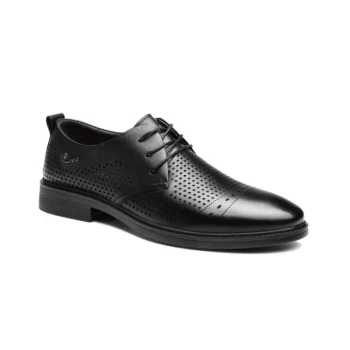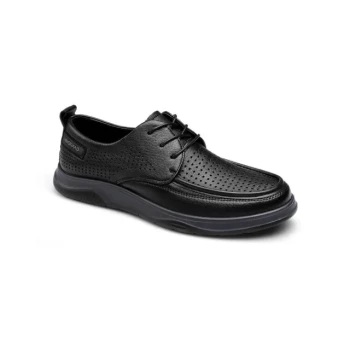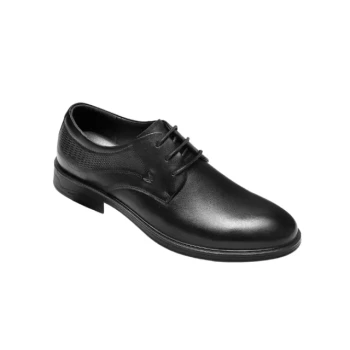In the world of quality footwear, the term Goodyear welt is a benchmark for craftsmanship. It is a traditional and labor-intensive method of shoe construction where a strip of leather, called the welt, is used to stitch a shoe's upper and sole together. This technique is highly valued because it creates an exceptionally durable, water-resistant, and repairable shoe, dramatically extending its lifespan far beyond that of more common, cemented constructions.
The core principle of a Goodyear welt is that it separates the shoe's upper from the outsole with two independent stitches. This small architectural detail is what transforms a shoe from a disposable item into a long-term, repairable asset that improves with age.
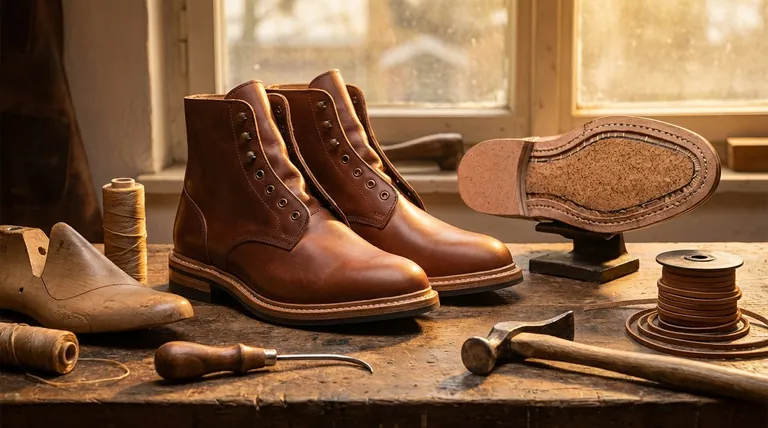
Deconstructing the Goodyear Welt: How It Works
To understand why this method is so revered, you must first understand its key components. Unlike a simple glued-on sole, the Goodyear welt creates a robust, multi-layered foundation.
The Central Role of the Welt
The welt is a dedicated strip of material, typically leather, that acts as a structural bridge. It runs along the perimeter of the shoe, connecting the upper to the outsole without either being directly stitched to the other.
Two Independent Stitches
The genius of the system lies in its two-part stitching process. First, an inseam stitch attaches the upper, lining, and insole to the welt. Second, a separate, heavy-duty outseam stitch attaches the welt to the outsole. This separation is critical for repair.
The Cork-Filled Cavity
Stitching the welt creates a cavity between the insole and the outsole. This space is filled with a layer of granulated cork. This material is lightweight, breathable, and provides excellent insulation.
The Core Benefits of This Construction
The intricate process of building a Goodyear welted shoe directly translates into three tangible benefits for the owner: repairability, durability, and a unique form of comfort.
Unmatched Repairability
This is the primary advantage. When the sole wears out, a cobbler can simply cut the outseam stitch, remove the old sole and cork, and attach a new one without ever touching the shoe's upper. This resoling process can be repeated multiple times, allowing a single pair of high-quality shoes to last for decades.
Superior Durability and Water Resistance
The double-stitch construction and the additional layers create an exceptionally strong and stable shoe. The welt acts as a barrier, making it significantly more difficult for water to penetrate the shoe from the ground up compared to simpler construction methods.
Custom Comfort That Develops Over Time
While initially firm, the cork footbed slowly compresses and molds to the unique shape of your foot with wear. This creates a customized footbed that provides unparalleled support and comfort, which only improves the more you wear the shoes.
Understanding the Trade-offs
No construction method is without its compromises. Acknowledging these is key to making an informed decision.
Initial Stiffness
Goodyear welted shoes are notoriously stiff out of the box. The multi-layered sole and cork filling require a break-in period for the shoe to soften and conform to your foot's movement.
Reduced Flexibility
The robust, layered construction results in a less flexible shoe when compared to more streamlined methods like Blake stitching or cemented construction. This adds to the feeling of sturdiness but reduces the immediate "sneaker-like" feel.
Higher Initial Cost
The process is complex, requiring skilled labor and specialized machinery. This investment in craftsmanship naturally leads to a higher purchase price than mass-market footwear with glued soles.
Is a Goodyear Welted Shoe Right for You?
Choosing the right shoe construction depends entirely on your priorities.
- If your primary focus is longevity and long-term value: The ability to resole the shoe makes the Goodyear welt the undisputed best choice for a lasting investment.
- If your primary focus is immediate, out-of-the-box comfort: You may prefer a different construction, as a Goodyear welted shoe requires a dedicated break-in period to achieve its signature comfort.
- If your primary focus is a sleek, low-profile silhouette: The welt adds visual and physical bulk, so more streamlined construction methods like Blake stitching might better suit your aesthetic.
Understanding this construction allows you to invest not just in a pair of shoes, but in a piece of craftsmanship built to last.
Summary Table:
| Feature | Benefit |
|---|---|
| Double-Stitch Construction | Creates a durable, water-resistant bond between the upper and sole. |
| Cork Filled Cavity | Molds to your foot for a custom, comfortable fit over time. |
| Separate Outsole Stitch | Allows for easy resoling, extending the shoe's lifespan for decades. |
| Leather Welt | Acts as a protective barrier, enhancing overall durability and structure. |
Ready to offer your customers footwear built to last?
As a large-scale manufacturer, 3515 produces a comprehensive range of Goodyear welted shoes and boots for distributors, brand owners, and bulk clients. Our production capabilities ensure you receive durable, high-quality footwear designed for long-term value and customer satisfaction.
Contact us today to discuss your manufacturing needs and elevate your product line with timeless craftsmanship.
Visual Guide
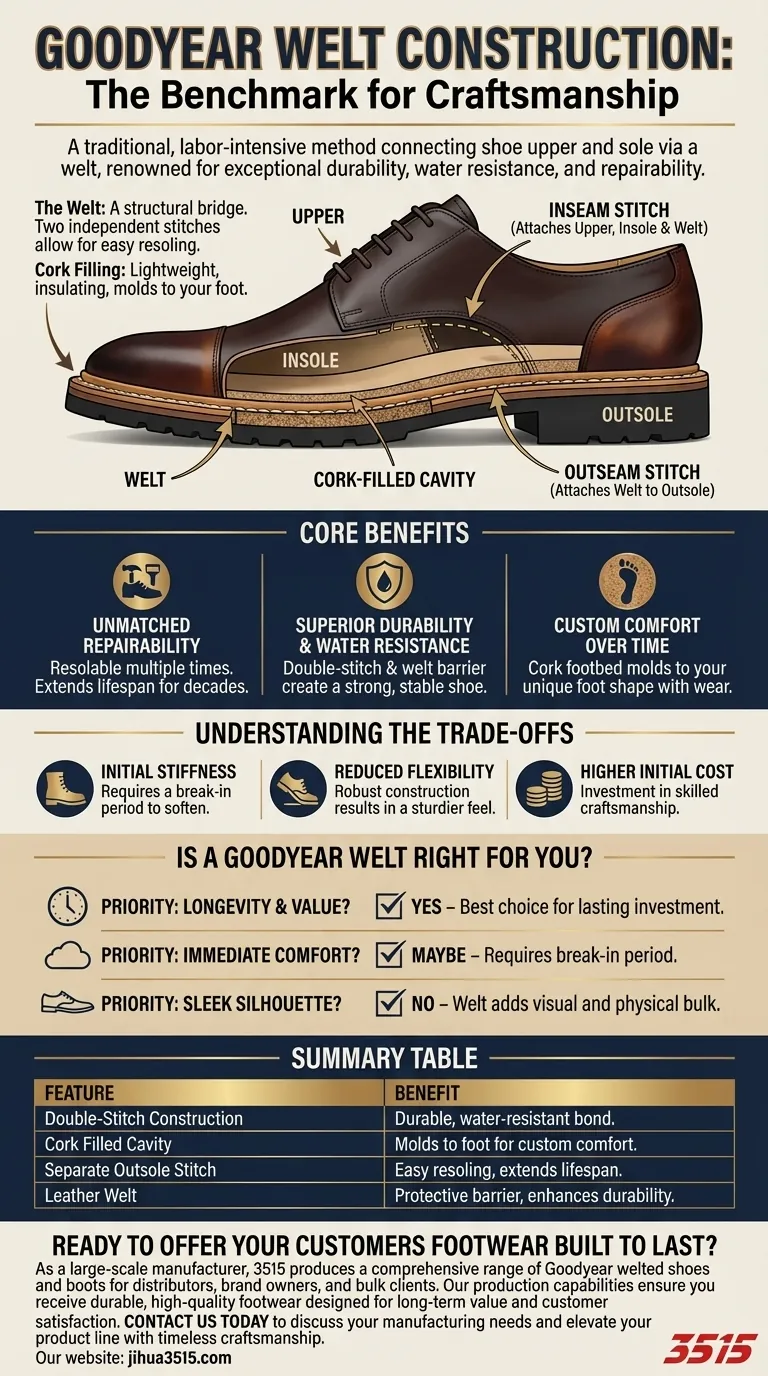
Related Products
- Custom Manufactured Air Cushion Leather Business Shoes for Wholesale
- Durable Rubber-Soled Utility Shoes for Wholesale & Custom Brand Manufacturing
- Wholesale Comfortable Business Casual Shoes Custom Manufacturing
- Wholesale Durable & Breathable Training Shoes for Custom Brands
- Wholesale Breathable Training Shoes Custom Athletic Footwear Manufacturer
People Also Ask
- How does leather compare to other shoe materials in terms of durability and comfort? A Material Guide for Footwear
- Can sneakers be part of a business casual wardrobe? Yes, with the right style and fit
- What are the characteristics of business casual sneakers? Master the Polished & Professional Look
- Why are sneakers now accepted in office environments? The Shift to Modern Professionalism
- Are sneakers acceptable in a business casual workplace? How to Choose the Right Style







